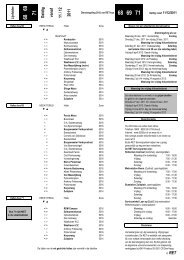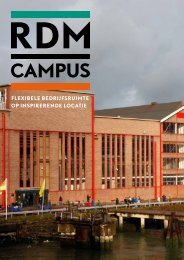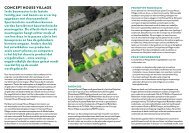Creating Comfortable Climatic Cities - RDM Campus
Creating Comfortable Climatic Cities - RDM Campus
Creating Comfortable Climatic Cities - RDM Campus
You also want an ePaper? Increase the reach of your titles
YUMPU automatically turns print PDFs into web optimized ePapers that Google loves.
20 <strong>Creating</strong> <strong>Comfortable</strong> <strong>Climatic</strong> <strong>Cities</strong>21<strong>Creating</strong> <strong>Comfortable</strong> <strong>Climatic</strong> <strong>Cities</strong>local energy production potentials and finding alternative biobased solutions forsynthetic plastics.Figure 5.OIL AND GAS LIQUIDSGlobal Oil and Natural Gas Liquids Production (The Association for the Study of Peak Oil and Gas,2004 SCENARIOC.J. Campbell, 2004) [Doepel Strijkers, 2012]Billion barrels a year (GB/a)353025201510501930 1940 1950 1960 1970 1980 1990 2000 2010 2020 2030 2040 2050US-48 Europe Russia other middle eastheavy etc. deepwater polar NGLSOURCE: THE ASSOCIATION FOR THE STUDY OF PEAK OIL AND GAS, C.J. CAMPBELL, 2004Energy poverty – Opportunities for designA rise in energy costs affects everyone, but especially the poor and people living farfrom amenities. In the early 1990s, Boardman (1991) used the term ‘fuel poverty’ in herpublication From Cold Homes to Affordable Warmth. More recently, the term ‘energypoverty’ has arisen to describe the point at which households spend more of theirdisposable income on energy than on rent. This phenomenon is already evident in theNetherlands. In 2011 it was estimated that approximately 300,000 households in thesocial rented sector spend more that the acceptable norm of 38% of their disposableincome on energy. Currently, 850,000 households are above the ‘energy poverty’borderline. Translated into percentages, 17% of social sector renters are above theacceptable norm and 5% spend more money on energy than on their monthly rent(Croon, 2012) (see Figure 6).The agenda for the architectural service industry is clear. A major energy renovationof the existing stock is needed, all new developments should be ‘energy neutral’ or‘energy plus’, and local potentials for renewable energy production and reuse ofwaste streams should be maximised.Figure 6.RELATION ENERGY & ACCEPTABLE LIVING EXPENSES IN SOCIAL RENT 2011Relationship between acceptable living costs in the social rented sector; 5% of households spend more on300.000 TENANTS SPEND MORE THAN ACCEPTABLE NORM OF 38% OF INCOME ON ENERGY (ORANGE)energy bills than on rent (Croon, 2012) [Doepel Strijkers, 2012]850.000 TENANTS ABOVE ENERGY POVERTY THRESHOLD€ 3.000€ 2.500€ 2.000€ 1.500€ 1.000€ 5001.000500€ 0 010 17,5 25 32,5 40 47,5 55 62,5 70 77,5 85 92,5 100% HOUSES (calculation ref. 1950 ground based, 110m 2 , 3 pers)SOURCE: CROON, 2012remaining acceptable income rent & taxes per month energy costsabove acceptable residential quote gas usage per yearM 3 gas5.0004.5004.0003.5003.0002.5002.0001.500According to Croon (2012), a short-term opportunity in the social rented sector is toretrofit 120,000 individual units each year. By linking the rent and energy costs, thetotal cost to renters remains the same, while the savings from energy reductionsover a fifteen-year period are invested upfront in energy reduction measures. Thechallenge is to retrofit a house in three days to A++ energy label standard, with anaverage investment of approximately €45,000. As the acceptable pre-investmentvaries per typology and is affected by aspects such as the age of the buildings andpredicted extension of their lifespan, a tailor-made strategy must be developed foreach user group and housing typology, and the logistical aspect of when to intervenemust be defined. The development of innovative and affordable retrofit solutions isessential if we are to counter this social economic challenge.Resource depletionAccording to the World Wide Fund for Nature (Loh et al., 2006), sometime in the 1980sthe rate of consumption of global resources exceeded the capacity of the earth toregenerate itself by 25%. Over the past decades the global rate of consumption hasincreased dramatically as the world population has grown exponentially, especiallyin China, India and Asia. Translated into space, mankind is using 1.5 times the naturalrenewable resources of the planet; if we proceed in this manner, by 2050 we will needthe equivalent of three planets to meet our needs.Besides the unsustainable patterns of consumption, there is a huge discrepancy inthe distribution and consumption of resources. Based on 2006 data from the GlobalFootprint Network and the corresponding 2003 CIA World Fact Book, Jerrad Pierce(2007) depicted the current global resource consumption per country and per capitain a single map (see Figure 7). In a world where resources are equally shared, each















